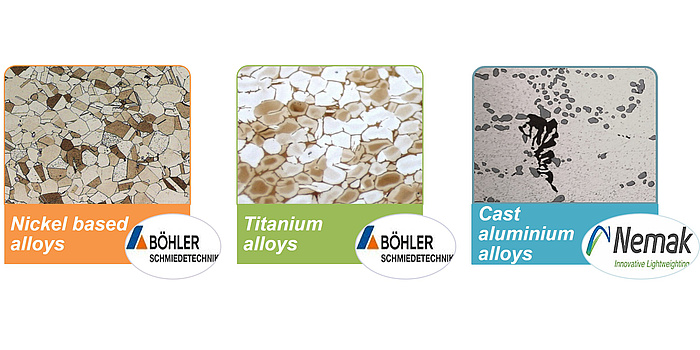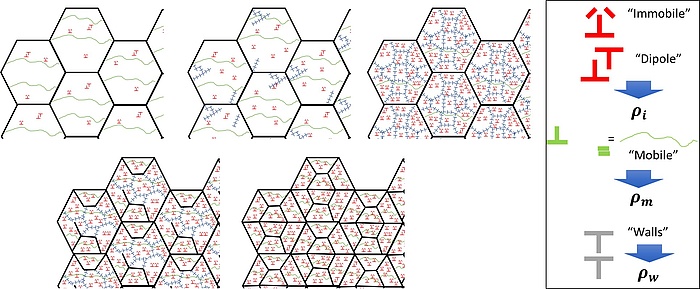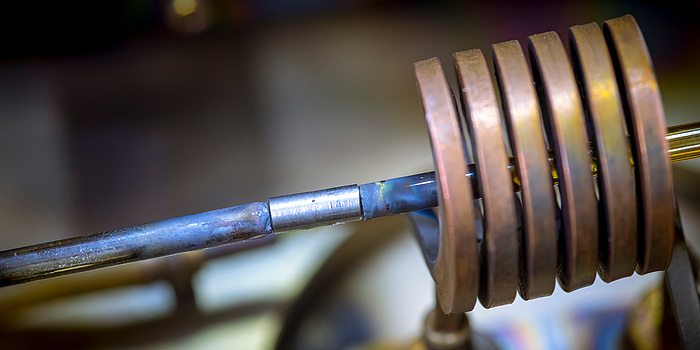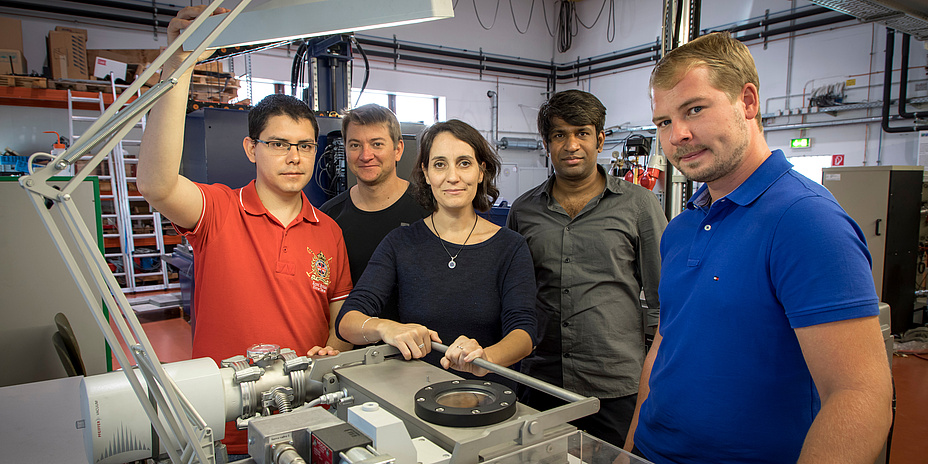The motivation behind the CD-Laboratory is given by the complexity of simultaneously physical phenomena taking place during industrial processes that involve plastic deformation and heat, as well as during service under thermomechanical loads. Our main objectives are to explain and model the microstructure evolution of non-ferrous materials during thermomechanical processing routes to obtain high performance during service.
We apply a combination of methodologies to achieve our objective: physical, phenomenological and thermodynamic modelling, finite element simulations, and experimental testing. The goals and methodology are summarized in the following paragraphs.
Unification
Unification of hot working, dislocation creep and relaxation phenomena in one simple physical based model can be generalized for different materials without losing accuracy and prediction potential. In general, scientists have modelled separately the development of a) the creep strain during service at high temperatures and loads, b) the flow stresses during hot/cold working, and c) the internal stresses during relaxation treatments. The models developed in the literature have been phenomenological and physical. One approach for the physical materials modelling consists of developing the mathematical and physical description of the microstructure, consistent constitutive equations, and the internal variable rate equations.

The CD lab consists of 3 modules: nickel-based alloys, titanium alloys and aluminium alloys.
The main tasks to develop the unified model are to find one unique description of the microstructure (such as in Fig. 1), to use the same internal variables, and to generate interchangeable constitutive equations. Further, the models can describe the microstructure evolution and the plastic response of the alloy along the processing chain, as well as in service. The internal variables to describe the microstructure include phases (deformable and non-deformable), different type of dislocation densities, misorientations, fraction of boundaries, etc, and their evolution rates describe dynamic as well as static phenomena.
Design
Design of experiments using traditional and cuttingedge technologies. In our CD lab the experiments are essential to understand and describe the behaviour of the material under thermal and mechanical loads, as well as to obtain numerical correlations and data. The evolution of flow stresses, creep strains and microstructural features are generated from experiments designed either to isolate physical phenomena, or to simulate industrial processes. We use a good amount of equipment located all over the world to achieve our objectives.
Microstructural evolution during plastic deformation of high-stacking fault-energy single-phased materials: a) undeformed material, b) formation of interior dislocations (immobile and dipoles) and wall dislocations, c) advanced dynamic recovery and formation of substructure, d) transformation of low-angle grain boundary into high-angle grain boundary, and e) fully recrystallized microstructure by continuous dynamic recrystallization (Ricardo Buzolin intermediate report, Module 2).
In situ experiments are the highlights of this laboratory. Since the evolution of microstructural features must be understood and quantified, we use methods such as dilatometry, differential calorimetry, X-ray diffraction with synchrotron sources, and microscopes with deformation/hot stages. These methods reduce the number of tests and allow the characterization of microstructural features in a way that is not possible when using postmolten samples, because the cooling can cause allotropic phase transformations, formation of defects and/or precipitates, among other modifications.
Monitoring
Monitoring the temporal and dimensional multiscale phenomena. In the first case, the models must be able to describe fast phenomena such as dynamic recovery and recrystallization together with slow phenomena such as grain growth or creep, without losing accuracy. When dealing with the geometry of samples as well as finished products, it is essential to determine the distribution of microstructural characteristics.

The strength and thermal stability of a product depends on the thermomechanical treatments during production.
The Christian Doppler Laboratory for Design of High-Performance Alloys by Thermomechanical Processing was launched on 1st May 2017 at the <link https: www.tugraz.at institute imat home _blank int-link-external external link in new>Institute of Material Science, Joining and Forming. The working group is composed of Cecilia Poletti (leadership), Friedrich Krumpals (post doc), Ricardo Buzolin, Kasyap Pradeep and René Wang (PhD candidates), Leander Herbitschek (technician) and Manuela Prader (secretary). The company partners are voestalpine BÖHLER Aerospace GmbH & Co KG, and Nemak Linz GmbH. The CD lab consists of 3 modules: Nickel¬based alloys, Titanium alloys and Aluminium alloys.
This project is anchored in the FoE <link https: www.tugraz.at en research fields-of-expertise advanced-materials-science overview-advanced-materials-science _blank int-link-external external link in new>„Advanced Materials Science“ one of TU Graz' five strategic areas of research.
Visit <link https: www.tugraz.at en tu-graz services news-stories planet-research current-articles _blank int-link-external external link in new>Planet research for more research related news.
Maria Cecilia POLETTI
Assoc.Prof. Dr.techn.
Institute of Material Science, Joining and Forming
Kopernikusgasse 24/I
8010 Graz
Phone: +43 316 873 1676
<link int-link-mail window for sending>cecilia.poletti@tugraz.at








